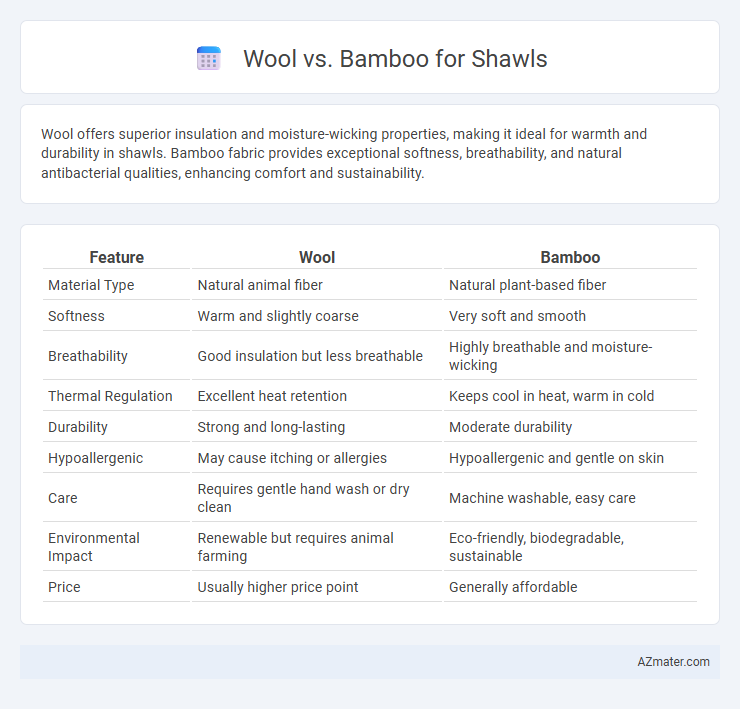Wool offers superior insulation and moisture-wicking properties, making it ideal for warmth and durability in shawls. Bamboo fabric provides exceptional softness, breathability, and natural antibacterial qualities, enhancing comfort and sustainability.
Table of Comparison
| Feature | Wool | Bamboo |
|---|---|---|
| Material Type | Natural animal fiber | Natural plant-based fiber |
| Softness | Warm and slightly coarse | Very soft and smooth |
| Breathability | Good insulation but less breathable | Highly breathable and moisture-wicking |
| Thermal Regulation | Excellent heat retention | Keeps cool in heat, warm in cold |
| Durability | Strong and long-lasting | Moderate durability |
| Hypoallergenic | May cause itching or allergies | Hypoallergenic and gentle on skin |
| Care | Requires gentle hand wash or dry clean | Machine washable, easy care |
| Environmental Impact | Renewable but requires animal farming | Eco-friendly, biodegradable, sustainable |
| Price | Usually higher price point | Generally affordable |
Introduction to Wool and Bamboo for Shawls
Wool, derived from sheep, offers excellent insulation, warmth, and breathability, making it a traditional favorite for shawls in colder climates. Bamboo fibers, sourced from bamboo grass, provide a soft, lightweight, and hypoallergenic alternative with natural moisture-wicking and antibacterial properties. Choosing between wool and bamboo for shawls depends on desired texture, warmth, and environmental considerations, with wool excelling in thermal regulation and bamboo standing out for sustainability and softness.
Natural Origins: Wool vs Bamboo Fibers
Wool fibers, derived from the fleece of sheep, are renowned for their natural insulation, moisture-wicking properties, and durability, making them ideal for warmth in shawls. Bamboo fibers, sourced from the pulp of bamboo plants, offer a sustainable alternative with breathable, hypoallergenic qualities and a silky texture that enhances comfort. Both fibers boast eco-friendly origins, but wool emphasizes animal-based warmth and resilience, while bamboo highlights plant-based softness and biodegradability.
Texture and Feel: Comfort Comparisons
Wool offers a warm, slightly coarse texture that provides excellent insulation, making it ideal for cold weather shawls but may feel itchy to sensitive skin. Bamboo fibers create a silky, smooth fabric that is naturally breathable and hypoallergenic, providing superior softness and comfort for those with delicate skin. Bamboo shawls maintain a cool, lightweight feel while wool shawls deliver durable warmth, making the choice dependent on individual comfort preferences and climate needs.
Warmth and Breathability of Wool vs Bamboo
Wool fibers provide superior warmth due to their natural crimp and loft, trapping heat efficiently while maintaining breathability through moisture-wicking properties. Bamboo fabric offers moderate warmth with excellent breathability and moisture absorption, making it cooler and more comfortable in milder conditions. Wool remains the preferred choice for shawls in colder climates, whereas bamboo is ideal for lightweight, breathable shawls suitable for transitional weather.
Durability and Longevity of Shawl Materials
Wool shawls offer exceptional durability due to their natural resilience, elasticity, and moisture-wicking properties, which prevent wear and tear over extended use. Bamboo shawls, while softer and more breathable, tend to be less durable because the fibers are more prone to pilling and weakening with frequent washing. Choosing wool enhances longevity for shawls that require sustained structural integrity and resistance to environmental stress.
Hypoallergenic Properties: Sensitive Skin Considerations
Bamboo fiber exhibits superior hypoallergenic properties compared to wool, making it an ideal choice for individuals with sensitive skin or allergies. Wool contains lanolin and can sometimes trigger irritation or itchiness, whereas bamboo is naturally antimicrobial and moisture-wicking, reducing the risk of skin reactions. Opting for bamboo shawls provides a softer, gentler fabric that promotes comfort for delicate skin types.
Sustainability and Environmental Impact
Wool, derived from sheep, is a renewable natural fiber but involves land use and methane emissions contributing to environmental concerns. Bamboo fabric is made from fast-growing bamboo plants that require minimal pesticides and water, making it a more sustainable alternative with a lower carbon footprint. However, the chemical-intensive process used to convert bamboo into soft fabric can impact its overall environmental benefits compared to responsibly sourced wool.
Care and Maintenance: Wool versus Bamboo
Wool shawls require careful hand washing in cold water with mild detergent to prevent felting and shrinking, while bamboo shawls can often be machine washed on a gentle cycle due to their durability and moisture-wicking properties. Wool fibers need to be dried flat to maintain shape and avoid stretching, whereas bamboo fabric dries quickly and resists wrinkles, reducing the need for ironing. Proper storage for both involves keeping them in a cool, dry place, but wool benefits from moth repellents due to its natural protein fibers that attract pests.
Style, Drape, and Aesthetic Appeal
Wool shawls offer a rich texture with excellent warmth, featuring a slightly heavier drape that enhances a classic, timeless style perfect for winter wear. Bamboo shawls provide a smooth, lightweight drape with a subtle sheen, adding a modern, elegant aesthetic ideal for layering in transitional seasons. The choice between wool and bamboo influences both the shawl's flow and visual impact, with wool emphasizing traditional warmth and bamboo highlighting softness and contemporary appeal.
Price Points and Value for Money
Wool shawls typically command higher price points due to their natural insulation, durability, and traditional appeal, making them a premium choice for cold weather. Bamboo shawls offer a more affordable alternative with exceptional softness, breathability, and moisture-wicking properties, delivering excellent value for money in warmer climates or transitional seasons. Consumers seeking long-term investment prioritize wool for warmth and longevity, while bamboo balances cost-effectiveness with eco-friendly benefits.

Infographic: Wool vs Bamboo for Shawl
 azmater.com
azmater.com